Choosing Your Birth Control Method
Choosing the Best Birth Control for You

Selecting which type of birth control to use can be very confusing. From birth control pills to birth control implants, there are many options to choose from. It helps to start by answering a few basic questions. Consider the following:
- How important is it for you to be protected from STDs? Not all birth control methods protect against STDs.
- How effective do you want your birth control? Some birth control methods are more effective than others.
- Are convenience and cost important in your decision? Do you want birth control that lasts a while? How much can you afford to spend on birth control?
- Does sexual pleasure affect your decision in selecting a birth control method? Do you want a birth control that enhances your sex life?
While abstinence is the only 100% effective birth control method, other methods can be almost as effective when used properly. Effectiveness of birth control methods is measured during “typical use”, meaning how effective the method is during actual use, including inconsistencies and incorrect use.
Natural Family Planning Method

What Is Natural Family Planning?
Not all birth control methods are associated with a device, medication, or procedure. Natural family planning, or fertility awareness, involves timing your sexual activity to avoid a woman's most fertile time. By understanding when a woman is most fertile, a couple can avoid pregnancy.
How Is Natural Family Planning Used?
A woman is most likely to get pregnant if she has unprotected sex during the five days prior ovulation, the day of ovulation, and a day or two after ovulation. There are a few different methods that can be used to predict when you will ovulate. Measuring basal body temperature and monitoring cervical mucus are ways to determine when a woman will ovulate. The calendar method is also useful in tracking your cycles on a calendar. Your health care professional can train you in the safest way to use this method correctly.
How Effective Is Natural Family Planning?
- Typical use: 76% effective
Pros
- Inexpensive or free
- Does not involve drugs or medical procedures
Cons
- No STD protection
- Keeping track of your cycle is required
- Spontaneity is limited
- Low effectiveness rate
Types of birth control: spermicide.
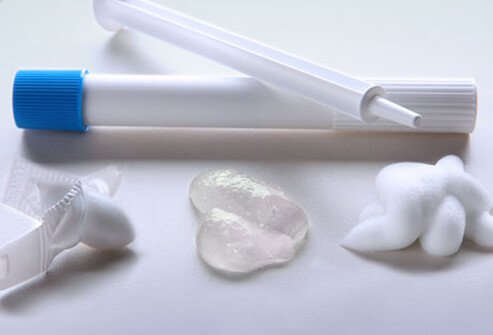
Spermicides are chemicals that kill sperm and prevent them from fertilizing the egg. They are available in different forms such as foams, creams, jellies, or films. Spermicides must be inserted deep into the vagina before sexual activity. Spermicide blocks the cervix and keeps the sperm from moving, which prevents the sperm from reaching the eggs. They are most commonly used in combination with other birth control methods, rather than alone.
How Effective Is Spermicide?
- Typical use: 72% effective
Pros
- Low cost (about $8 per package)
- Easy to use
- Can be inserted by a partner as foreplay
- Extremely easy to purchase
- Can be used during breastfeeding
Cons
- No STD protection
- May be messy
- May irritate the penis or vagina
- Low effective rate if used alone
Male Condoms

Glow-in-the-dark condoms, flavored condoms, studded condoms and many more provide birth control that can make your sex life safe and exciting! The male condom is a barrier method involved in preventing contact between sperm and egg. Latex male condoms are the classic methods of barrier contraception, but they can be made of natural animal membrane, polyurethane, silicone, or other synthetic material. During ejaculation, a condom is designed to catch semen, stopping it from entering the vagina.
How to Put on a Condom
Everyone who is sexually active should know how to put on a condom. If you want it to work properly, you have to know how to use it. Luckily it's super easy! Start with the condom on the tip of the erect (hard) penis and roll it down toward the base of the penis. Make sure there is a small pouch at the condom tip so it can catch the ejaculated semen. After ejaculation, hold on to the condom at the base of the penis before removal from the vagina in order to avoid leakage. Condoms are not reusable. Keep track of the condom's expiration date, as expired condoms should not be used.
How Effective Are Condoms?
- Typical use: 82% effective
Pros
- STD prevention
- Extremely easy to purchase
- Inexpensive, some are even free. The average condom costs about $1.
- Very easy to use
- Male condoms can provide increased sensation for both partners. Try experimenting with different styles, shapes, flavors, and textures of male condoms.
- Can be used for oral, anal, and vaginal sex.
- Can be used with other birth control methods
Cons
- One-time use
- Required every time you have sex
- Must be used properly in order for effectiveness
- Not as effective as other birth control methods
Female Condom
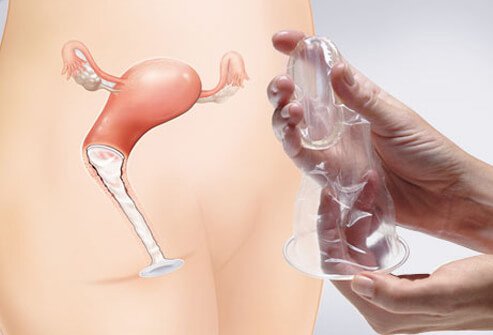
Looking for a way to enhance your sex life and practice safe sex? This birth control option is a plastic, pouch-like device inserted in the vagina before sex that offers clitoral stimulation. The female condom can also be inserted into the anus prior to anal sex. The female condom has flexible rings at each end that can stimulate the clitoris during vaginal sex.
How Do Female Condoms Work?
Female condoms can be inserted up to 8 hours prior to sexual activity, and they are very simple to use. Female condoms can be inserted by a partner as part of foreplay. To insert a female condom, first apply lubricant or spermicide to the outside of the closed end. Next, squeeze the sides of the ring at the closed end and insert it into the vagina like a tampon. Push the inner ring into the vagina as far as it can go, until it reaches the cervix. The outer ring will hang about an inch from the vagina. Once the pouch is inserted, the ring at the closed end holds it in the vagina and sperm is prevented from entering the vaginal canal.
Don’t worry if you feel the condom move side to side, that is normal. You should definitely stop intercourse if the penis slips between the condom and the vagina or if the outer ring is pushed into the vagina. Once your partner has ejaculated, squeeze and twist the outer ring to keep the semen in the pouch. Gently pull the female condom out of the vagina or anus and throw it away.
How Effective Are Female Condoms?
- Female condom effectiveness with typical use: 79% effective
Pros
- STD prevention
- Safe, simple, and convenient
- Extremely easy to purchase
- Inexpensive, about $4 each
- Offers clitoral stimulation
- Allows additional foreplay
Cons
- Not as effective as other birth control methods
- May cause irritation of the vagina, vulva, penis, or anus
- Reduced sensation during intercourse
- Crackling or popping noise may occur during intercourse
Diaphragm
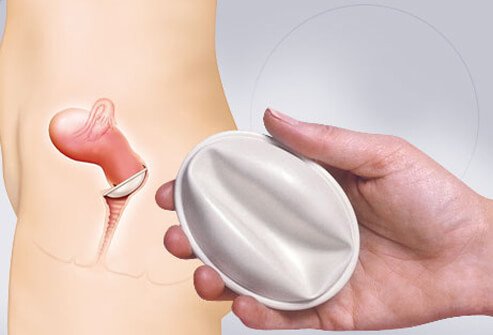
Although not as popular as other birth control methods, the diaphragm is another way to prevent conception. The diaphragm is a rubber dome that is inserted into the vagina and placed over the cervix before sexual activity. When the diaphragm is in place, the opening to the uterus is blocked and the sperm is unable to join with an egg.
How Is the Diaphragm Used?
Inserting the diaphragm is not as simple as using condoms, but practice makes perfect. Start by washing your hands with soap and water. Put about a tablespoon of spermicide in the cup and around the rim. Find a comfortable position and separate the lips of the vulva with one hand. With the other hand, pinch the rims of the diaphragm to fold it in half. For a firmer grip, place your index finger in the center of the fold. Push the diaphragm as far up and back into the vagina as possible. Make sure your cervix is covered and tuck the edge of the diaphragm behind the pubic bone.
The diaphragm must be left in for six hours after the last time you had sex. If you have sex more than six hours after the last time you had sex, leave it in but put more spermicide deep into the vagina. Do not leave the diaphragm in for more than 24 hours.
To remove the diaphragm, start by washing your hands with soap and water. Place a finger into your vagina and hook the rim of the diaphragm. Pull the diaphragm down and out and wash it with mild soap and warm water to prevent infection.
How Effective Is the Diaphragm?
- Typical use: 88% effective
Pros
- Low cost ($15-$75 every two years)
- Can be used during breastfeeding
- Immediately effective and reversible birth control
- Cannot be felt by you or partner
- Reusable
Cons
- No STD protection
- Requires a doctor visit for fitting
- Cannot use during menstruation
- May be difficult to insert
- Must be placed prior to sex, every time
- Spermicide may have side effects
The Caya Diaphragm
Caya is a newer type of diaphragm that is made out of silicone, which provides a more comfortable and durable product. Caya also has an updated design that makes insertion and removal easier.
Cervical Cap
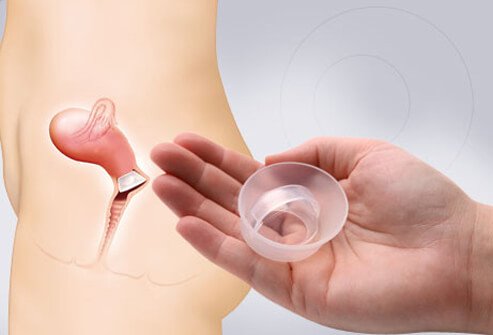
A cervical cap is another barrier method of contraception. It is smaller than a diaphragm and fits over the cervix. Like the diaphragm, a cervical cap is used with spermicide. The cervical cap blocks the opening to the uterus and prevents sperm from joining with an egg. FemCap is the only brand of cervical cap available in the United States.
How Is a Cervical Cap Used?
Inserting the cervical cap can be tricky. Start by washing your hands with soap and water. Put one-quarter teaspoon of spermicide in the cervical cap and on the brim. Put one-half teaspoon in the folded areas between the brim and the dome. Find a comfortable position and separate the lips of the vulva with one hand. With the other hand, squeeze the rim of the cap together. Slide the cervical cap dome-side down into your vagina, with the long brim entering first. Push down toward the anus and then up onto the cervix. Make sure the cervix is completely covered.
The cervical cap must be left in for six hours after the last time you had sex. If you have sex more than six hours after the last time you have sex, leave it in but put more spermicide deep in your vagina. Do not leave the cervical cap in for more than 48 hours.
To remove the cervical cap, start by washing your hands with soap and water. It is easiest if you squat down and pull the removal strap while rotating the cervical cap. You can push the dome with your finger to break the suction and pull the cervical cap out. Wash it with mild soap and warm water.
How Effective Is the Cervical Cap?
- Cervical cap effectiveness typical use: 88% effective
Pros
- Low cost ($0-$75 every two years)
- Can remain in place up to 48 hours
- Cannot be felt by you or your partner
- Can be used during breastfeeding
Cons
- No STD protection
- Requires a doctor visit for fitting
- Cannot use during menstruation
- May be difficult to insert
- Must be placed prior to sex, every time
- Spermicide may have side effects
Today Sponge

The Today Sponge is a small, doughnut-shaped, foam sponge saturated with spermicide. The sponge is inserted into the vagina and placed against the cervix. A nylon loop attached to the bottom of the sponge makes removal extremely simple. The sponge covers the cervix and blocks sperm from entering the uterus. The Today Sponge is the only available birth control sponge in the United States.
How Is the Today Sponge Used?
The Today Sponge is much easier to use than a diaphragm or cervical cap. The sponge can be inserted up to 24 hours prior to sexual activity. To insert the Today Sponge, start by washing your hands with soap and water and also wet the sponge with at least two tablespoons of clean water. Gently squeeze the sponge in order to activate the spermicide. Next, fold the sides of the sponge up and away from the loop to make it look long and narrow. Use your finger to slide the sponge far back into your vagina. Once the sponge is inserted, it will unfold and cover the cervix. You can slide your fingers around the edge of the sponge to make sure it is in position.
The Today Sponge must be left in place for at least six hours after the last time you have sex. Do not leave the Today Sponge in for longer than 30 hours.
To remove the Today Sponge, start by washing your hands with soap and water. Luckily, the sponge is a lot simpler to remove than the diaphragm and cervical cap. Put a finger inside your vagina and through the loop. Gently pull out the sponge. The sponge is not reusable, so make sure to always throw it away after removal.
How Effective Is the Today Sponge Contraceptive?
- Typical use: 88% effective for women who have never given birth
- Typical use: 76% effective for women who have given birth
Pros
- Immediate effectiveness
- Prescription and doctor visit not required
- Cannot be felt by your or your partner
- Can be used during breastfeeding
Cons
- No STD protection
- May be difficult to insert
- May cause vaginal irritation
- May make sex too messy because of the required liquid
- May make cause vaginal dryness
Birth Control Pills

The birth control pill, "the pill," is the most common method of hormonal contraception. The birth control pill is taken daily, and most pills use a combination of estrogen and progestin hormones.
How Do Birth Control Pills Work?
Basically, birth control pills are made of hormones, and hormones are chemicals made in our bodies. Our hormones control how different parts of our bodies work. Birth control pills contain a small amount of man-made estrogen and progestin hormones, which work to prevent eggs from leaving the ovaries. If there is no egg to join the sperm, there is no pregnancy. Birth control pills also make the cervical mucus thicker, which keeps sperm from joining with the eggs.
Side Effects of Birth Control Pills
Some women have side effects with the birth control pill, but their bodies are usually able to adjust over time. Common birth control pill side effects include the following:
- Bleeding between periods
- Breast tenderness
- Nausea and vomiting
- Change in sexual desire
Birth control pills rarely cause serious problems, but here are a few health problems caused by birth control pills:
- Blood clots
- Increased potassium in your blood
- Heart attack
- Stroke
- High blood pressure
- Liver tumors
- Gallstones
- Yellowing of the skin or eyes
Types of Birth Control Pills
There are two types of birth control pills, combination pills and the minipill. Combination pills contain both estrogen and progestin, and the minipill contains only progestin. The amount of estrogen in combination pills can vary. Depending on the type of combination pills, there may be 21 active pills and seven inactive pills or 24 active pills and four inactive pills. The minipill only comes in one formula, and all pills in the pack are active.
How Effective Are Birth Control Pills?
- Typical use: 91% effective
Pros
- Very effective
- May reduce menstrual cramping
- May lead to lighter periods
- Cost may be covered by your health insurance
- Doesn't interrupt sexual activity
Cons
- No STD protection
- Cost is $15 to $50/month, if not covered under your health insurance
- Requires a doctor visit and prescription
- Side effects
- Must be taken daily
Birth Control Patch

The birth control patch is another type of hormonal contraceptive. The patch is thin like a bandage, and contains the same hormones as birth control pills.
How Is the Birth Control Patch Used?
The birth control patch is applied to the skin and left in place for a week. The patch is extremely easy to use. You can either stick it to the skin of your buttocks, stomach, upper outer arm, or back. Make sure to avoid oils, lotions, and makeup around the area you chose. The patch is changed weekly for 3 weeks, then for the fourth week no patch is worn.
The patch contains estrogen and progestin, which prevent pregnancy by keeping the eggs in the ovaries and thickening the cervical mucus. Keeping the eggs in the ovaries make them inaccessible to the sperm, meaning no pregnancies.
Birth Control Patch Side Effects
Some women have side effects with the birth control patch, but their bodies are usually able to adjust over time. Common side effects of the birth control patch include the following:
- Bleeding between periods
- Breast tenderness
- Nausea and vomiting
- Change in sexual desire
- Skin irritation
Birth control patches rarely cause serious problems, but here are a few rare serious side effects of the birth control patch:
- Blood clots
- Heart attack
- Stroke
- High blood pressure
- Liver tumors
- Gallstones
- Yellowing of the skin or eyes
Remember, these serious side effects are extremely uncommon.
How Effective Is the Birth Control Patch?
- Birth control patch effectiveness with typical use: 91% effective
Pros
- May reduce menstrual cramping
- May lead to lighter periods
- Applied only once a week
- Cost may be covered by your health insurance
Cons
- No STD protection
- May cost up to $80/month, if not covered by your health insurance
- Side effects
- Requires a doctor visit and prescription
Vaginal Ring (NuvaRing)
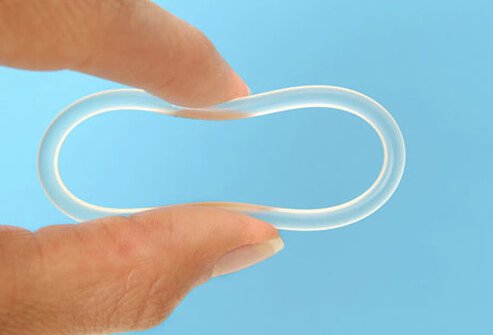
The vaginal ring is a small, flexible ring that contains the same hormones as the pill and patch, estrogen and progestin. The hormones in the vaginal ring keep the eggs from leaving the ovaries and thicken the cervical mucus, which prevents pregnancies. It is worn inside the vagina to prevent pregnancies. The vaginal ring is also known as NuvaRing, its brand name.
How Is the Vaginal Ring Used?
NuvaRing is fairly easy to use. Start by washing your hands with soap and water. Next, insert the NuvaRing into your vagina by pressing the sides of the ring together and pushing the ring into your vagina. Don’t worry about the exact location of the NuvaRing, it doesn’t matter. A NuvaRing is inserted into the vagina and left in place for three weeks.
After three weeks, remove the NuvaRing by hooking your finger under the forward rim and pulling it out. You will then go one week without NuvaRing, this usually corresponds to when you will have your period. After exactly one week, insert a new NuvaRing into your vagina.
How Effective Is the Vaginal Ring?
- Vaginal ring effectiveness with typical use: 91% effective
Vaginal Ring Side Effects
Some women have side effects with NuvaRing, but their bodies are usually able to adjust over time. Common side effects of NuvaRing include the following:
- Bleeding between periods
- Breast tenderness
- Nausea and vomiting
- Change in sexual desire
- Irritation of the vaginal
NuvaRing rarely cause serious problems, but here are a few rare serious side effects of NuvaRing:
- Blood clots
- Heart attack
- Stroke
- High blood pressure
- Liver tumors
- Gallstones
- Yellowing of the skin or eyes
Pros
- May reduce menstrual cramping
- May lead to lighter periods
- Cost may be covered by your health insurance
Cons
- No STD protection
- May cost up to $80/month, if not covered by your health insurance
- Side effects
Birth Control Shot (Depo-Provera)

A hormonal injection called Depo-Provera can protect against pregnancy for three months.
How Does the Birth Control Shot Work?
A doctor will inject you with Depo-Provera every 12 weeks in the arm or buttocks. The hormone in the birth control shot, progestin, will work with the body to prevent pregnancy. Depo-Provera keeps the eggs from leaving the ovaries and makes the cervical mucus thicker. Keeping the sperm from the eggs will prevent pregnancy.
How Effective Is the Birth Control Shot?
- Birth control shot effectiveness with typical use: 94% effective
Birth Control Shot Side Effects
Some women have side effects with Depo-Provera, but their bodies are usually able to adjust over time. Common Depo-Provera side effects include the following:
- Irregular bleeding
- Breast tenderness
- Change in appetite or weight gain
- Depression
- Hair loss or increased hair on face or body
- Headache
- Nausea
- Change in sexual desire
- Irritation of the vagina
Pros
- Very effective
- Only injected once every 12 weeks
- Does not contain estrogen
- Cost may be covered by your health insurance
Cons
- No STD protection
- May cost up to $240/year, if not covered by your health insurance
- Side effects
Birth Control Implant (Implanon and Nexplanon)

The same hormone in the birth control shot can be delivered in an implant. Implanon and Nexplanon are brands of birth control implants. The hormone in the implant, progestin, works with the body to prevent the eggs from leaving the ovaries. Since the eggs stay in the ovaries, the sperm is unable to join the egg.
The implant is a small, matchstick-sized device implanted beneath the skin of the upper arm. A doctor will numb a small area of your arm and insert the implant. After 4 years or any time before this that you wish, the implant will be removed by a doctor.
How Effective Is the Birth Control Implant?
- Birth control implant effectiveness with typical use: 99.95% effective
Pros
- Long-lasting
- Very effective
- Can be used while breastfeeding
- Cost may be covered by your health insurance
Cons
- No STD protection
- May cost up to $800, if not covered by your health insurance
- Irregular bleeding for the first 6-12 months
- May cause longer, heavier periods
- May be associated with side effects similar to those of other hormonal contraception methods
IUD (Intrauterine Device)

The IUD, or intrauterine device, is a small, T-shaped device inserted by a doctor into the uterus. It prevents pregnancy for a number of years. ParaGard is the name for an IUD that contains copper and can be in place for up to 10 years. There are three types of hormonal IUDs. Mirena is inserted for up to 5, and Skyla and Liletta are effective for up to 3 years. All types of IUDs are highly effective.
How Does an IUD Work?
Both the copper and the hormonal IUDs work by preventing the sperm from joining an egg. For women using a hormonal IUD, the eggs are unable to leave the ovaries and the cervical mucus is thickened. This means that the eggs and sperm will not join together.
How Effective Is an IUD?
- IUD effectiveness typical use: 99% effective
Pros
- Long-lasting
- May reduce period cramps
- Cost may be covered by your health insurance
- May reduce menstrual flow
Cons
- No STD protection
- Requires doctor visit and costs up to $1000 (lasts up to 10 years, depending on the type)
- Mild to moderate pain when IUD is inserted
- Spotting between periods from the first 3-6 months
- Irregular periods in the first 3-6 months (with Mirena or Skyla)
- Heavier periods and worse menstrual cramps (with ParaGard)
- May slip out of place
Tubal Ligation
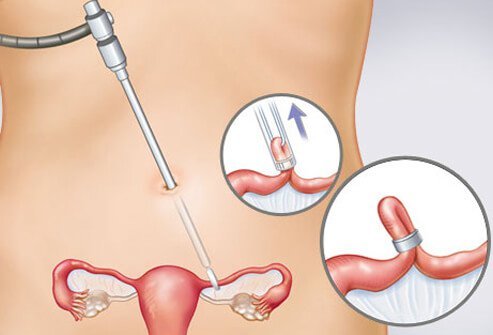
The tubal ligation procedure, or having "your tubes tied," is a permanent birth control option for women who are certain they do not want to have children in the future. Tubal ligation is a surgical procedure that blocks, ties, or cuts the fallopian tubes so eggs do not travel into an area where contact with sperm is possible.
How Effective Is Tubal Ligation?
- 100% effective
Pros
- Highly effective
- Permanent
Cons
- No STD protection
- Surgery required
- May not be reversible
- Costly
Tubal Implants

Tubal implants are small metal springs or sponges are placed inside the fallopian tubes to block them and permanently prevent pregnancy. Tubal implants do not require surgery; they are guided through the vagina, cervix, and uterus until they are lodged in a fallopian tube. The implants are made of metal or silicone and cause scar tissue to form and block the fallopian tubes. It takes a few months for the scar tissue to form. Once the scar tissue has formed, the eggs will not be able to travel from the ovaries to the fallopian tubes, where eggs are normally fertilized by sperm.
How Effective Are Tubal Implants?
- Tubal implant effectiveness: 100% effective
Pros
- Permanent
- Surgery not required
- Very effective
Cons
- No STD protection
- Delay of a few months until effective
- May not be reversible
- Costly
- May increase risk of infection
Vasectomy

Vasectomy is a permanent birth control option for men. Vasectomy is the surgical closure of the vas deferens, the tubes that transport sperm from the testes. Instead of ejaculating sperm, the body will absorb the sperm and release sperm-free ejaculate.
How Effective Is Vasectomy?
- Vasectomy effectiveness: Nearly 100% effective
Pros
- Effective
- Permanent
Cons
- No STD protection
- Costly, may cost up to $1,000
- Surgery required
- May not be reversible
- Not immediately effective
Emergency Contraception

If you need protection after having sex, you may want to consider emergency contraception. Emergency contraception can be hormonal or non-hormonal and it is used after sex to protect against pregnancy if no birth control was used.
Emergency Contraceptive Pill
Examples of emergency contraceptives include Plan B, Plan B One-Step, and Next Choice. All of these contain a high dose of a hormone used in birth control pills, and they must be taken within 72 hours of sexual activity. Ella is a new type of emergency contraception that uses a non-hormonal drug and can be used up to 5 days after sexual activity.
Copper T IUD
The Copper T IUD is one of the most effective methods of emergency contraception. There are no hormones in the Copper T IUD. There is a tiny copper filament wrapped around the T shape of the IUD that prevents the sperm from coming in contact with the eggs.
How Effective Are Emergency Contraceptives?
- Emergency contraception effectiveness: Pills- 89% effective if taken within 72 hours of unprotected sex
- Copper T IUD- 99% effective
Birth Control for Older Women

Lifestyle factors and age are important in choosing a birth control option. Women approaching menopause may have an extra benefit from hormonal birth control methods, since they may help relieve symptoms of perimenopause. Remember that unless a woman has reached menopause (absence of a period for 12 consecutive months), she is still capable of getting pregnant.
Withdrawal (Pulling Out) Method

The withdrawal method or "pulling out," involves the man withdrawing his penis prior to ejaculation. If using the withdrawal method of birth control, be careful to make sure that no semen leaks into the woman's vulva. It is very important for men to understand their own sexual response and know when they are going to ejaculate.
How Effective Is the Pulling Out Method?
- Withdrawal method effectiveness with typical use: 86% effective
Pros
- Free
- Does not involve drugs or medical procedures
Cons
- No STD protection
- Difficult to do correctly
- Requires self-control, experience, and trust
- Not recommended for men who ejaculate prematurely
Least Effective Birth Control Methods

Without birth control, about 85% of couples will become pregnant in a year. Using any type of birth control is better than using none at all. The following are the least effective birth control methods:
- No birth control-15% effective
- Spermicide -72% effective
- Fertility awareness- 76% effective
- Female condom- 79% effective
- Withdrawal (pulling out)- 86% effective
Most Effective Birth Control Methods

While abstinence is the only birth control method that is 100% effective, hormonal contraceptives, IUDs, and permanent birth control methods are also highly effective. Barrier methods are moderately effective for typical users. The following are the most effective birth control methods:
- Implant, IUD, vasectomy, and tubal methods- 99% effective
- Birth control shot- 94% effective
- Birth control pill and vaginal ring- 91% effective
- Condom, diaphragm, cervical cap, and birth control sponge- 79-88% effective
Choosing Your Birth Control Method
IMAGES PROVIDED BY:
- Asia Images Group / Getty,PhotoAlto / Ale Ventura, Thomas Tolstrup / Photographer's Choice
- Hemera / Getty
- Steve Pomberg / WebMD
- Steve Pomberg / WebMD
- Peggy Firth and Susan Gilbert, CMI, for WebMD, Keith Brofsky / Thinkstock
- Peggy Firth and Susan Gilbert, CMI, for WebMD, Maggie Murray / Photolibrary
- Steve Pomberg / WebMD, Peggy Firth and Susan Gilbert, CMI, for WebMD
- Steve Pomberg / WebMD, Peggy Firth and Susan Gilbert, CMI, for WebMD
- Don Farrall / Photolibrary
- Philippe Garo / Photo Researchers, Inc.
- sodapix / Photolibrary
- ERproductions Ltd / Blend Images
- PHANIE / Photo Researchers, Inc.
- Peggy Firth and Susan Gilbert, CMI, for WebMD
- Peggy Firth and Susan Gilbert, CMI, for WebMD
- Peggy Firth and Susan Gilbert, CMI, for WebMD
- Peggy Firth and Susan Gilbert, CMI, for WebMD
- Cordelia Molloy / Photo Researchers, Inc.
- Jetta Productions / Walter Hodges / Photolibrary
- George Diebold / Getty
- iStockphoto / Thinkstock
- Corbis
REFERENCES:
- CDC: “Contraception.”
- CDC: “Effectiveness of Family Planning Methods.”
- Planned Parenthood: “Spermicide & Contraceptive Gel.”
- Association of Reproductive Health Professionals: "Choosing a Birth Control Method"
- CDC: "Effectiveness of Family Planning Methods", "Contraception"
- Planned Parenthood: "Spermicide", "Condom", "Diaphragm", "Cervical Cap (FemCap)", "Birth Control Sponge (Today Sponge)", "Birth Control Patch", "Birth Control Vaginal Ring (NuvaRing)", "Birth Control Shot (Depo-Provera)", "Morning-After Pill (Emergency Contraception)"
- Princeton.edu: "What Is Emergency Contraception"
- U.S. Department of Health and Human Services: "Fertility Awareness (including Natural Family Planning) Fact Sheet"
- U.S. Food and Drug Administration: "Essure Permanent Birth Control"
© 1996-2022 WebMD, LLC. All rights reserved.
Source slideshow on OnHealth


